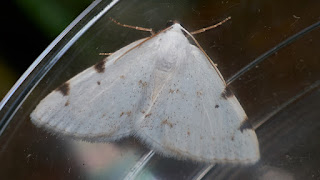First things first. No doubt you have been bombarded by letters and emails concerning the change to the data protection laws. As a result of this Google specify that they will add a notice to this blog explaining their privacy policy to readers. I do not know where this will be placed, so you may have already seen it.
I wanted to make the title "Everything you wanted to know about root canal fillings but were afraid to ask" but that seemed a little unwieldy so I used a truncated version to give you a taster. What has this to do with our visit to Millenheath? Please be patient ... all will be revealed.
Millenheath is situated a couple of miles south of Prees Heath to the east of the A41. We had been asked by Shropshire Wildlife Trust to take a look at three sites within an area of farmland sandwiched between the A41 and Twenlows Big Wood consisting of a bridle path and two fields.
Finding the site was the first issue as spotting the turning off the A41, a busy road at the best of times, was not the easiest or safest occupation for a driver. As I got there early I posted myself at the end of the lane by the A41 in the hope that I would assists approaching drivers to realise where they were and not overshoot.
Eventually we had all arrived and assembled in a field that the owner had kindly offered to us for safe parking. After the usual greetings and preparation we set off and headed for the bridle path.
For once we had a firm plan of campaign - the bridle path first followed by Field 1, which bordered the path, then field 2, which was set apart from the other two areas.
The bridle path runs along a green lane that starts off very straight and tree-lined as though at one time it was a drive to somewhere now long gone. The vegetation here is very lush and dominated by nettle and cleavers.
In amongst the nettles a pair of mating Tipula maxima:
 |
| Photograph: David Williams |
 |
| Photograph: Bob Kemp |
 |
| Photograph: David Williams |
 |
| Photograph: David Williams |
Star-of-Bethlehem was spotted in the verge.
 |
| Photograph: Bob Kemp |
 |
| Photograph: Bob Kemp |
You can get some idea of the size from the gate and the person at its foot on the left. We did not measure it but I estimate that its circumference is 5 - 6 metres.
We had now come to the gate into the first of the two fields that we were visiting. Time had passed quickly and so we entered the field and had lunch.
 |
| Photograph: Bob Kemp |
 |
| Photograph: Bob Kemp |
 |
| Photograph: Bob Kemp |
As we approached the end of the field the longhorn beetle with a name whose length matches its magnificent antennae - Agapanthia villosoviridescens - was spotted on some thistles.
Leaving the field the conversation somehow moved on to dentistry and more specifically root canal fillings. Many of us had undergone this form of treatment and one of us had carried it out. How we got started on the subject is one of the many great mysteries of life ... but we did.
I will not burden you with the details but the discussion carried on ...
And on ....
And on until we reached the next field at least a quarter of an hour later.
The second field was completely different in character. On one side, bordering the woodland, it was very sandy and dry with sparse vegetation and on the other side it was damper supporting lusher vegetation with numerous marsh thistle spikes.
 |
| Photograph: Bob Kemp |
 |
| Photograph: David Williams |
 |
| Photograph: David Williams |
A teneral male Common blue damselfly was photographed clinging to a grass.
 |
| Photograph: David Williams |
 |
| Photograph: David Williams |
 |
| Photograph: David Williams |











































































